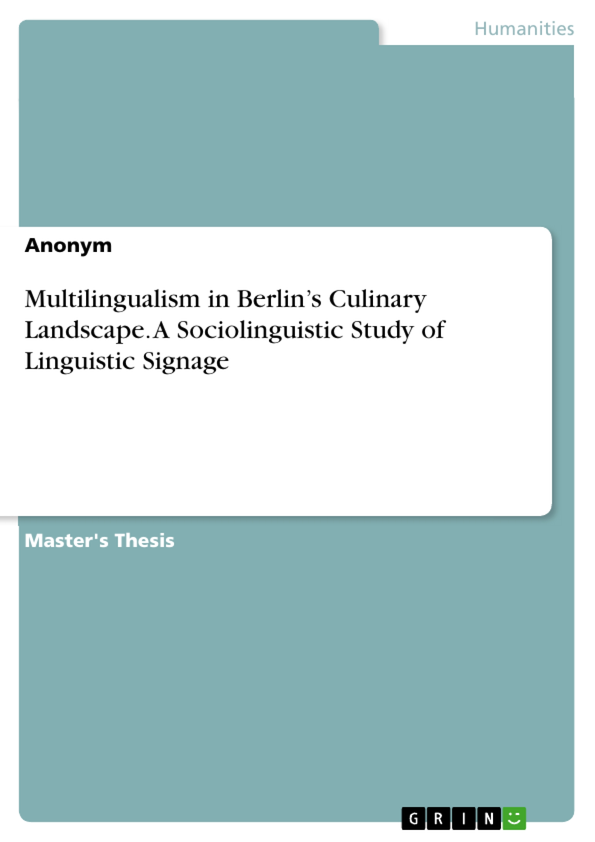
Multilingualism in Berlin’s Culinary Landscape. A Sociolinguistic Study of Linguistic Signage
Masterarbeit, 2023
74 Seiten
Leseprobe
Table of Contents
- 1 Introduction
- 2 Literature Review
- 2.1 Linguistic Landscape as a Research Field
- 2.2 Linguistic Landscape of Berlin
- 2.3 Food as a Linguistic Phenomenon
- 2.4 Previous Studies on Linguistic Landscape of Food
- 3 Methodology
- 3.1 Research Design
- 3.2 Research Questions
- 3.3 Research Area
- 3.4 Research Instruments
- 3.5 Data Collection
- 3.6 Data Categorization
- 4 Data Analysis
- 4.1 Quantitative Analysis
- 4.1.1 Charlottenburg
- 4.1.2 Mitte
- 4.1.3 Kreuzberg
- 4.1.4 Lichtenberg
- 4.1.5 The Overview of All Four Districts
- 4.2 Qualitative Analysis
- 4.2.1 Charlottenburg
- 4.2.2 Mitte
- 4.2.3 Kreuzberg
- 4.2.4 Lichtenberg
- 4.1 Quantitative Analysis
- 5 Discussion & Conclusion
- 5.1 Interpretation of Findings
- 5.2 Limitations and Suggestions
- 5.3 Conclusion
Objectives and Key Themes
This study examines the linguistic landscape of food in four Berlin neighborhoods (Mitte, Lichtenberg, Kreuzberg, and Charlottenburg) to determine the prevalence and distribution of languages in culinary zones, explore the role of multilingualism, investigate the impact of socio-cultural and demographic factors, and assess the influence of English. The research aims to contribute to the understanding of linguistic patterns in diverse urban locations and the evolution of language in the context of globalization and urbanization.
- The prevalence and distribution of languages in Berlin's culinary linguistic landscape.
- The role of multilingualism in reflecting language dynamics, sociolinguistic identities, and ethnic diversity in Berlin's food industry.
- The impact of socioeconomic and demographic factors on the culinary linguistic landscape.
- The influence of English on the linguistic landscape of food in Berlin.
- The connection between language, cuisine, and metropolitan areas.
Chapter Summaries
1. Introduction: This chapter introduces the concept of linguistic landscapes, focusing on their significance in reflecting sociolinguistic diversity within urban environments. It defines linguistic landscapes based on Landry & Bourhis (1997), highlighting the analysis of linguistic expressions in urban settings to uncover their relationship with economic, linguistic, political, and sociocultural characteristics. The chapter also discusses the expansion of the definition by other scholars, focusing primarily on written signs due to research complexities. The chapter establishes the research questions which will guide the analysis of the linguistic landscape of food in Berlin neighborhoods.
2. Literature Review: This chapter reviews existing literature on linguistic landscapes, specifically focusing on the research field itself, the linguistic landscape of Berlin, food as a linguistic phenomenon, and previous studies that specifically examine linguistic landscapes related to food. The review lays the groundwork for the current study by providing a comprehensive overview of existing knowledge and identifying gaps in the research.
3. Methodology: This chapter outlines the research design, including the research questions, the selected research area (four Berlin neighborhoods), the research instruments used for data collection and analysis (not specified in provided text), data collection methods, and data categorization strategies. The detailed methodology section ensures transparency and replicability of the study.
4. Data Analysis: This chapter presents the results of both quantitative and qualitative analyses of the data collected from the four Berlin neighborhoods. The quantitative analysis likely involves statistical measures related to language prevalence on food-related signage, while the qualitative analysis may include thematic analysis based on observations of linguistic patterns and their context. The chapter systematically presents findings for each neighborhood and compares them to provide a comprehensive overview of the linguistic landscape across the chosen areas.
Keywords
Culinary linguistics, multilingualism, Berlin, linguistic landscape, globalization, English, gentrification, sociolinguistics, demographics, menu, advertisements, global influence, economic factors.
Frequently asked questions
What is the main topic of this language preview?
This language preview outlines a study that examines the linguistic landscape of food in four Berlin neighborhoods: Mitte, Lichtenberg, Kreuzberg, and Charlottenburg. It provides information on the research's objectives, key themes, methodology, and intended analysis.
What are the objectives of this study?
The study aims to:
- Determine the prevalence and distribution of languages in culinary zones.
- Explore the role of multilingualism in reflecting language dynamics, sociolinguistic identities, and ethnic diversity in Berlin's food industry.
- Investigate the impact of socio-cultural and demographic factors.
- Assess the influence of English on the linguistic landscape of food in Berlin.
- Examine the connection between language, cuisine, and metropolitan areas.
What key themes are explored in this study?
The key themes include:
- Language prevalence and distribution in Berlin's culinary linguistic landscape.
- The role of multilingualism.
- The impact of socioeconomic and demographic factors.
- The influence of English.
- The connection between language, cuisine, and metropolitan areas.
What methodology is used in this study?
The methodology involves a research design that includes:
- Specific research questions.
- The selection of four Berlin neighborhoods (Mitte, Lichtenberg, Kreuzberg, and Charlottenburg) as the research area.
- Research instruments for data collection and analysis (details not fully specified).
- Data collection methods.
- Data categorization strategies.
What data analysis methods are employed?
The study utilizes both quantitative and qualitative data analysis methods. The quantitative analysis likely involves statistical measures of language prevalence on food-related signage. The qualitative analysis may involve thematic analysis based on observations of linguistic patterns and their context.
What are the key words associated with this study?
The key words include: Culinary linguistics, multilingualism, Berlin, linguistic landscape, globalization, English, gentrification, sociolinguistics, demographics, menu, advertisements, global influence, economic factors.
What is the definition of linguistic landscapes used in this research?
The study defines linguistic landscapes based on Landry & Bourhis (1997) as the analysis of linguistic expressions in urban settings to uncover their relationship with economic, linguistic, political, and sociocultural characteristics. The research primarily focuses on written signs due to the complexities of analyzing other forms of linguistic expression.
What does the literature review cover?
The literature review covers existing research on:
- Linguistic landscapes as a research field.
- The linguistic landscape of Berlin.
- Food as a linguistic phenomenon.
- Previous studies on linguistic landscapes related to food.
What is the purpose of the introduction chapter?
The introduction chapter introduces the concept of linguistic landscapes and establishes the research questions that guide the analysis of the linguistic landscape of food in Berlin neighborhoods.
Details
- Titel
- Multilingualism in Berlin’s Culinary Landscape. A Sociolinguistic Study of Linguistic Signage
- Hochschule
- Universität Bayreuth
- Autor
- Anonym (Autor:in)
- Erscheinungsjahr
- 2023
- Seiten
- 74
- Katalognummer
- V1588059
- ISBN (Buch)
- 9783389141786
- Sprache
- Englisch
- Schlagworte
- multilingualism berlin’s culinary landscape sociolinguistic study linguistic signage
- Produktsicherheit
- GRIN Publishing GmbH
- Preis (Ebook)
- US$ 34,99
- Preis (Book)
- US$ 49,99
- Arbeit zitieren
- Anonym (Autor:in), 2023, Multilingualism in Berlin’s Culinary Landscape. A Sociolinguistic Study of Linguistic Signage, München, Page::Imprint:: GRINVerlagOHG, https://www.diplomarbeiten24.de/document/1588059
- Autor werden
- Ihre Optionen
- Vertriebskanäle
- Premium Services
- Autorenprofil
- Textarten und Formate
- Services für Verlage, Hochschulen, Unternehmen

- © GRIN Publishing GmbH.
- Alle Inhalte urheberrechtlich geschützt. Kopieren und verbreiten untersagt.
- info@grin.com
- AGB
- Open Publishing
Der GRIN Verlag hat sich seit 1998 auf die Veröffentlichung akademischer eBooks und Bücher spezialisiert. Der GRIN Verlag steht damit als erstes Unternehmen für User Generated Quality Content. Die Verlagsseiten GRIN.com, Hausarbeiten.de und Diplomarbeiten24 bieten für Hochschullehrer, Absolventen und Studenten die ideale Plattform, wissenschaftliche Texte wie Hausarbeiten, Referate, Bachelorarbeiten, Masterarbeiten, Diplomarbeiten, Dissertationen und wissenschaftliche Aufsätze einem breiten Publikum zu präsentieren.
Kostenfreie Veröffentlichung: Hausarbeit, Bachelorarbeit, Diplomarbeit, Dissertation, Masterarbeit, Interpretation oder Referat jetzt veröffentlichen!
- GRIN Verlag GmbH
-
- Nymphenburger Str. 86
- 80636
- Munich, Deutschland
- +49 89-550559-0
- +49 89-550559-10
- info@grin.com
-









